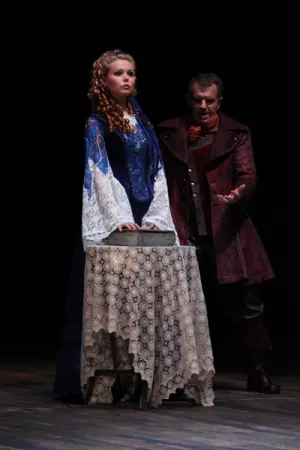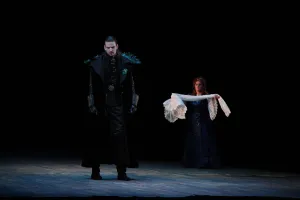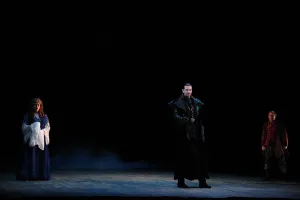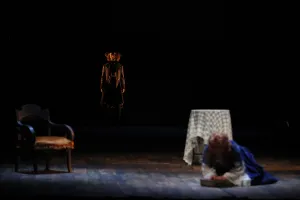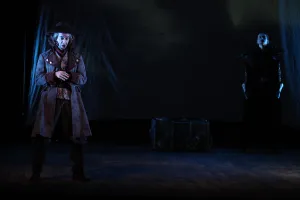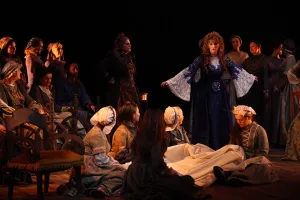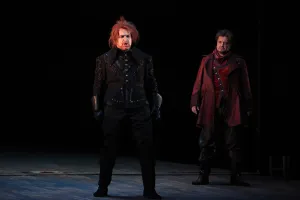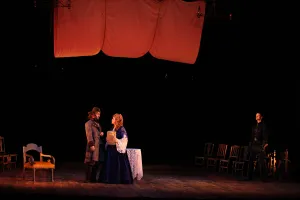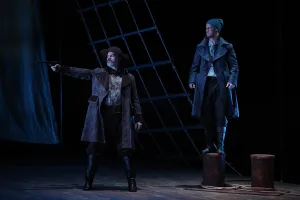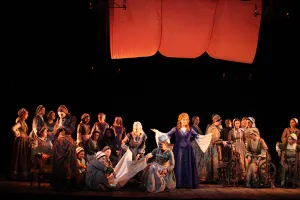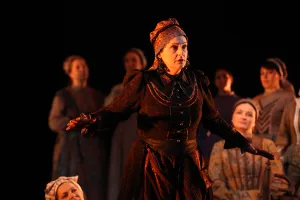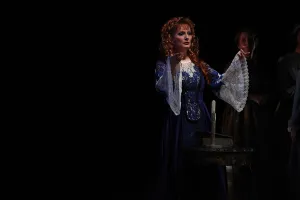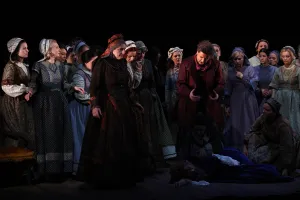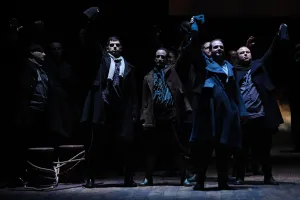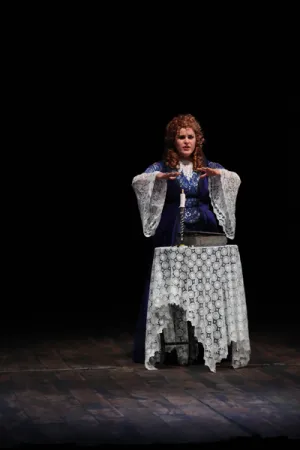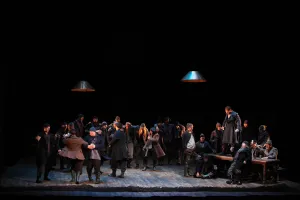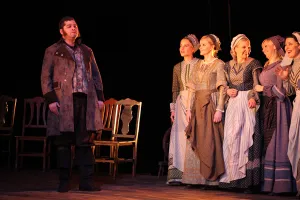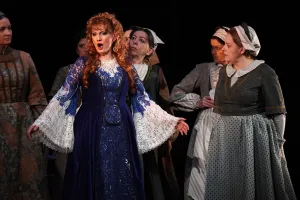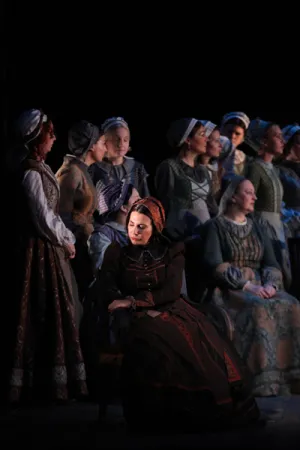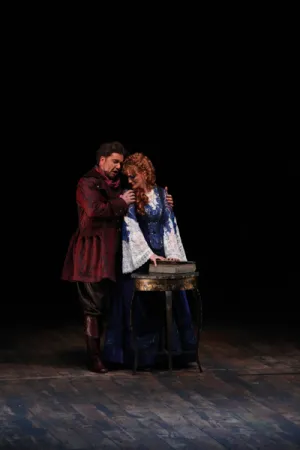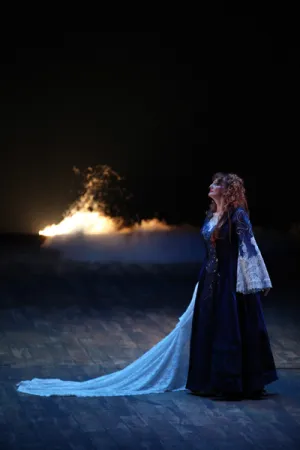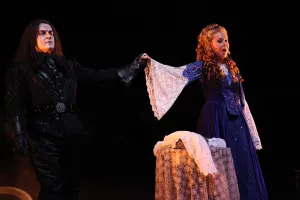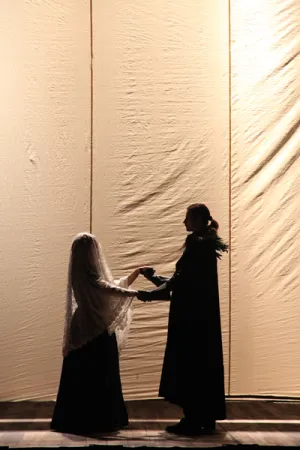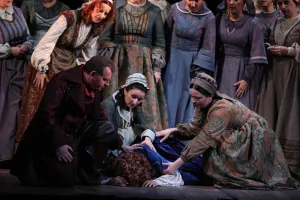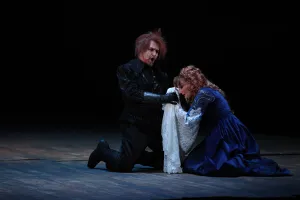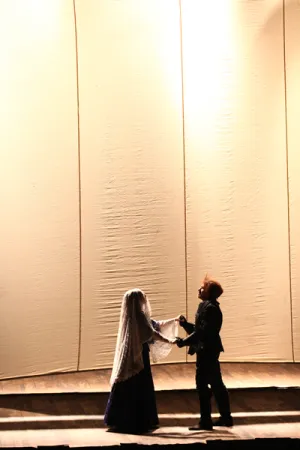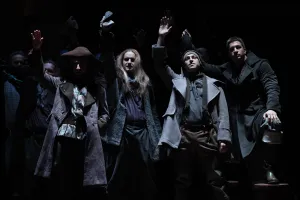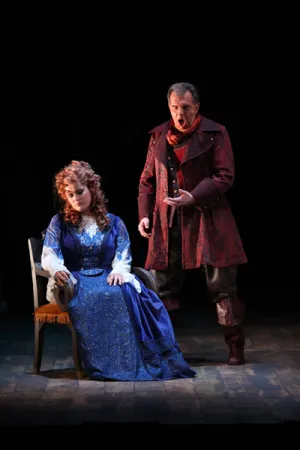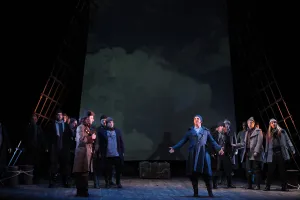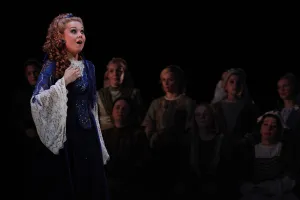Der fliegende Holländer
opera by Richard Wagner

SAIL – GATE OF TIME
The old captains’ house on the very seashore in Boka Kotorska, where my maternal ancestors used to live, has always been an endless source of stories for me, ever since my early childhood. However, the greatest challenge to a boy’s imagination were the framed pictures of sailboats dominated by giant sails, full with wind, as if waiting for a suitable moment to take off to the sky with clouds. They resembled gates that invite to past, present, future, parallel or, maybe, timeless periods of time itself. The vision of blinding whiteness where one can catch a glimpse of two silhouettes came into my mind when listening to the closing lines of Wagner’s opera The Flying Dutchman. I wanted the audience to see the immense sail, which comes up from ocean depths and rises in the air lit with blinding white light, and the two purified souls who find each other to stay together for all times in front of that giant sail, which covers all possible realities. Then, everything falls into darkness. This is how I offered the two themes of visual motifs I designed and developed for the production – the motif of wandering (a sail) and the motif of catharsis (bridal veil). Hell’s fire disappears in front of the blinding whiteness and the black veils of sorrow blend into the whiteness of a loyal bride. Silhouette of a ship with torn sails emerges and becomes larger and larger through the image of stormy and fiery sea. At the apex of sound tension, silhouette of the ship is replaced by a giant silhouette of the Dutchman. For one moment, we can see both the Dutchman in reality and his wondering spirit in flames. There are also the shadows of his former brides to be, who remained unwed (the occult meaning of number six only emphasises the meaning of their presence on stage) all in black, with unlit wedding candles in hands. In the second act, while waiting for their seamen, a group of young women devotedly spins yarn, the other group mends fabric and the third group lifts and rearranges white fabric that resembles clouds, sea waves, and endless ocean voyages…
Wagner gives a suggestion that defies logic, “On the wall in the depths of the stage, there is a portrait of a man of pale complexion with a black beard and a black cloak over his shoulders…” No sailor (and all of them are superstitious) would ever put up a portrait of somebody they do not know in their house, especially if that is a portrait of a person who obviously brings bad luck. For that reason, my Senta is obsessed with reading a book in which, amongst other things, there is a legend about the Flying Dutchman, illustrated with his portrait. The portrait of a pale man in black captivates Senta. She tells the story about him over the flickering candle light to terrified and superstitious girls. However, by saying the magic word “Yoho-hoe!”, Senta unwillingly, as if with a mantra, opens a time portal and we can see “brides to be in black”, coming from some ancient abyss of hell, and bridesmaids who live their lives in reality. Senta seems to exist in both parallel realities. She is the only one who can perceive both groups of women, they cannot see each other; so, she thanks the bridesmaids for the flowers and takes the wedding gown from “brides in black”. But, when the gate of time opens in the third act during the sailors’ drinking party, chaos must prevail. Therefore, after the doomed ship’s crew appears on the stage, the time starts running in accordance to their reality, and when they start walking on stage, the time of the living visibly slows down and their movements and gestures are in slow motion: everybody who sees the notorious ship and its crew has to die! The doomed sailors put their huge fishing net over the living sailors and, like fishermen of human souls, take them into the depths of hell. Everything that exists disappears under the immense sail that comes up from the floor and, with its whiteness and purity, covers sorrow, fear, love, hope, joy. The audience presumes that the two purified souls have united on the other side of the gate of time. The two themes of visual motifs have been closed. This is how a punishing sail becomes a cloud of hope and redemption; this is how the two silhouettes become a symbol of eternity. When this version of The Flying Dutchman ends, we may think of one of Wagner’s leading motifs, according to our inclination and the situation, when we find ourselves entering a magic world by passing through a gate of time, just as we do when we pass the theatre portal, without even being aware of that.
DEJAN MILADINOVIĆ
taken from his essay of the same title, published in:
Collection of Essays WAGNER’S ESSAY ON OPERA AND DRAMA TODAY
Matica Srpska, Novi Sad, 2007
PRESS CUT
THE FLYING DUTCHMAN
"... Director-designer Dejan Miladinovic successfully stripped away the excessive stage machinery common to this work. Employing only a steeply raked stage, sails, rope rigging and minimal props to detail specific scenes, he concentrated instead on the innate drama of the characters. There were some excellent visual effects - images of the Dutchman silhouetted against his sails, or the glitter of his heaping treasure chest dancing before Daland's eyes - all deftly used to serve the drama rather than compete with it ..."
Opera News, New York, August, 1998
 RICHARD WAGNER
RICHARD WAGNER
Wilhelm Richard Wagner was born on 22nd May 1813 into a middle-class family. His early ambition was to become a poet; however, at the age of 16, he saw Beethoven’s opera Fidelio and decided to dedicate himself to music. He studied music in Leipzig. In 1831, while still a student of music, he composed his first opera and wrote the libretto for it as well, which he would continue to do throughout his life. At the age of 20, he worked as a music director in a theatre in Magdeburg. Later on, he lived and worked in Riga and Paris, where he became involved in left-wing politics. He moved to Dresden, where he participated in the May Uprising in 1849, after which he was forced to flee Germany. He returned to Germany only in 1864, and settled in Bayreuth near Munich, where he was able to work on his ideas: far away from cultural scenes of big cities – in a theatre he designed – the audience was able to focus on studying interaction between the music and action on the stage. Construction of this unique opera house, and a mansion which he called Wahnfried (Freedom from Illusion), was funded by King Ludwig who became and remained Wagner’s lifelong patron. In August 1976, on the occasion of grand opening of his uniquely designed opera house (Bayreuth Festspielhaus), Wagner organised a four-day festival, which featured the world premiere of his The Ring of the Nibelung. The festival in Bayreuth remains active to this day; the festival’s programme contains exclusively Wagner’s pieces. His whole life, Wagner had a recurring problem of having to escape from creditors and his mistresses’ husbands. After the death of his first wife Minna, he was in an out-of-marriage relationship with Cosima, daughter of Franz Liszt (the reason why Liszt and Wagner did not communicate in years) and wife of conductor Hans von Bulow, a friend of Wagner’s and one of his most ardent fans. The birth of their illegitimate daughter Isolde caused such a scandal that Wagner and Cosima had to leave Munich. They got married in August 1870, after having two more illegitimate children – Eva and Siegfried. Due to his bad health, Wagner went to Venice and died of a heart attack there on 13th February 1883. He was buried in Bayreuth. Wagner’s interests were diverse – he composed and conducted music, he wrote poetry, essays and musical reviews. He was one of the best-educated people in the XIX century Europe; he translated all 12 volumes of Homer’s Iliad; he was fascinated with Shakespeare and the Middle Ages’ literature; later on, he was fascinated with Germanic and Nordic myths and the works of Schopenhauer and Nietzsche. Nonetheless, he is best known as an opera art reformer. He advocated for “total artwork” (Gesamtkunstwerk) and he called opera “the music drama” and considered it the synthesis of all arts: music, drama (literature) and visual art. Wagner’s best-known operas are: The Mastersingers, Lohengrin, The Flying Dutchman, Tannhauser, Tristan and Isolde, The Ring of the Nibelung (The Rhinegold, The Valkyrie, Siegfried, The Twilight of the Gods), Parsifal.
According to: www.bastabalkana.com
www.zanimljivamuzika.com
http://artie.rs/magazin
 DEJAN SAVIĆ
DEJAN SAVIĆ
Dejan Savić (1957), an outstanding Serbian conductor, graduated conducting with distinction at the Academy of Music in Belgrade and received his Master’s Degree at the Academy of Arts in Novi Sad. Since 1993, Mr. Savić has been the Principal Conductor and, in two mandates, the Manager of Opera and Ballet Companies in the National Theatre in Belgrade. In the period between 2005 and 2007, Mr. Savić held the office of the General Manager in the National Theatre and again, since 2012, he has resumed the same leading position in the National Theatre. Besides his continuous engagement in the National Theatre, he has been an Artistic Director of Niš Symphony Orchestra, as well as a music manager of “Pro Classica” Chamber Orchestra, Chamber Ensemble “Pro Musica” and „The Baruh Brothers" Choir. Mr. Savić has conducted numerous renowned international orchestras; several renowned Greek symphony orchestras, including those in Athens and Thessaloniki and he has been a guest conductor of the National Symphony Orchestra of Greek Radio (ERT). In the course of his career, he has conducted the following orchestras: Bloomingdale Symphony Orchestra (New York); Bulgarian Radio Symphony Orchestra and National Philharmonic from Ruse (Bulgaria); Symphony and Chamber Orchestra of Rumanian National Radio in Bucharest; Rhine Philharmonic and Opera Choir (Germany); National Opera and Ballet Company from Krasnoyarsk (Siberia); Portuguese Orchestra from Algarve; and many companies in Italy – Polyphonic Choir “David Brunori” and Philharmonic Orchestra of Marche Region; Italian International Orchestra and Choir of Ventidio Basso Theatre in Ascoli Piceno; Gioachino Rossini Symphony Orchestra from Pesaro; City Choir from Bitonto; Giuseppe Verdi Philharmonic Orchestra in Salerno; Chamber Orchestra of Puglia, etc. One should not forget the Choir and Symphony Orchestra of the Serbian National Broadcasting Company (RTS) and Belgrade Philharmonic Orchestra. He performed in opera houses in Dublin (Ireland), Athens and Thessaloniki (Greece), Strasbourg (France), Sofia (Bulgaria), Oslo (Norway), Vienna (Austria), Bucharest (Rumania), Burgas (Bulgaria). With the National Theatre and with companies he conducts, as well as individually, he has also performed in Israel, Holland, Switzerland, Spain, Cyprus, etc. His national and international successes have been recorded in numerous audio and video recordings. He has received numerous awards for his artistic achievements.
 ANA ZORANA BRAJOVIĆ
ANA ZORANA BRAJOVIĆ
Ana Zorana Brajović was born in Belgrade in 1975. She graduated at the Piano Department at The Faculty Music Arts in Belgrade, in the class of Professor Mirjana Šuica Babić. Later on, she obtained her Master’s Degree in conducting in the class of Professor Jovan Šajnović. She won the October Prize for her accomplishments in music in 1995, as the youngest candidate. Ana Zorana won the first prize for performance and co-repetition in “Boris Hristov” Competition in Sofia in 2000. She received Fulbright scholarship for 2003/04 and studied at the Peabody Conservatory, Baltimore, USA, in the class of Professor Gustav Meier. As of 1st October 1994, she worked as an assistant conductor, and as of 2000/01, she became permanently engaged as a conductor in the Opera and Ballet companies in the National Theatre in Belgrade. As the youngest conductor in the Opera Company, she conducted Mozart’s Magic Flute in 1995. In 2006, Ana Zorana conducted at the world premiere of opera Violet Fire by Jon Gibson, an opera on Nikola Tesla. In period between 2007 and 2012, she conducted in the regular repertoire in the National Theatre; amongst other accomplishments, she revived operas The Barber of Seville (2010) and The Masked Ball (2011). With performance of Rossini’s The Barber of Seville, she celebrated 20 years of her artistic work on 24th November 1994. She started her career in 1991 as a pianist, by performing in numerous concerts in Serbia and abroad. In 1995, she held a Promenade Concert at Zaduzbina Ilije M. Kolarca accompanied by the Symphony Orchestra of the Serbian Broadcasting Corporation, when she performed both as a pianist and as a conductor. Since then, she has performed frequently with this orchestra and in 2003, with the Orchestra and the Choir of the Serbian Broadcasting Corporation, she recorded a CD – Deus Absconditus, suite by Aleksandar Kostić. She participated at the concert “Millennium Stage” in Kennedy Center in Washington, DC. In cooperation with musicians of the Metropolitan, she participated in the Brooklyn Music Festival in New York in 2006. She performed in opera houses in Baltimore and Washington, DC. In cooperation with the Philharmonic Orchestra of Sarajevo, she conducted Giselle in the National Theatre in Sarajevo, in 2011.
 DEJAN MILADINOVIĆ
DEJAN MILADINOVIĆ
Dejan Miladinović was born in Belgrade, into a family of opera artists. In 1971, he graduated from the Department of Theatre Direction with the production of Jelisaveta’s Love Plight, (Theatre Atelier 212) and in 1976, he received the Master’s Degree in Theatrical Arts from the Academy for Theatre in Belgrade with the thesis Development of Opera Direction in Belgrade and Novi Sad in period 1919-1975. Miladinović has served as first Stage Director at Opera and Drama companies and Artistic Director of the Opera Company in the Serbian National Theatre in Novi Sad. He has also served as Director and Artistic Consultant for "Grand Opera Projects" with Convention Centre "Sava" in Belgrade. In 1978, he has assumed the position of a Stage Director in Opera of the National Theatre in Belgrade and in 1997, he has become Artistic Director in the same company. Since April 2005, he again has served as Artistic Director at Serbian National Theatre in Novi Sad and since October 2006, Artistic Director at Opera & Theatre Madlenianum in Zemun. Since season 2012/13, he has been appointed the head of the National Theatre’s Opera in Belgrade. He has worked as an Associate Professor and Artistic Director of Opera Theatre at Meadows School of Arts, Southern Methodist University, Dallas, Texas; Associate Professor of Opera Theatre at Music Conservatory, Belgrade; and Associate Professor at Thornton School of Music, University of Southern California, Los Angeles, California. Miladinović has staged more than 160 productions with professional companies in former Yugoslavia and abroad (USA and Canada). He has cooperated with numerous renowned composers, conductors and international opera stars. He has directed most first productions of music and stage pieces of national composers. Besides direction, he has written librettos (The Power of Virtue, by Kuljerić, Prometheus by Bruci, Mandragola by Jevtić – verse by V. Miladinović, Merry Priests of Banat by Despić – verse by V. Miladinović), composed music and designed sets for drama productions. Miladinović is the only triple laureate for direction by the international jury at Yugoslav Chamber Opera and Ballet Festival – Osijek Annual. He was also awarded with “Jovan Đorđević” Golden Medal of Serbian National Theatre for outstanding accomplishments in operatic art (2006). Miladinović “is an artist of imaginative, bold and unconventional conception. He has directed numerous operas with resounding success. Both audiences and critics unanimously and with delight favour his productions for their obvious theatrical quality and modern direction” (Yugoslav Music Encyclopaedia, Zagreb). Radoslav Lazić, PhD, wrote, “…Josip Kulundžić, PhD Branko Gavela, PhD Erih Hecel, as well as Mladen Sabljić, Jovan Putnik and Dejan Miladinović have given foundation to modern Serbian opera theatre. They are the creators of Serbian opera theatre of the twentieth century and its aesthetics” (The Art of Direction, Novi Sad).
Premiere performance
Premiere 23. december 2013. / Main stage
Opera in three acts
Libretto by Richard Wagner
Conductors Dejan Savić, Ana Zorana Brajović
Director Dejan Miladinović
Assistant Conductor for singer's rehearsals Rade Pejčić
Assistant Director Ana Grigorović
Set Designer Dejan Miladinović
Costume Designer Katarina Grčić Nikolić
Language Instructor Karolina Beter
Selection of video captions Dejan Miladinović
Translation adn caption preparations Gavrilo Rabrenović
Premiere Cast:
Dutchman Miodrag D. Jovanović / Stefan Pavlović
Senta Ana Rupčić / Slađana Pavlović* guest artist / Tanja Andrijić* guest artist
Daland Nenad Jakovljević / Dragoljub Bajić / Mihailo Šljivić
Erik Dejan Maksimović / Janko Sinadinović
Mary Dubravka Filipović / Tamara Nikezić
Sailor Darko Đorđević / Danilo Stošić / Nenad Čiča
*Artists engaged in rehearsals of the production
ORCHESTRA AND CHOIR OF THE NATIONAL THEATRE'S OPERA COMPANY
Concertmaster Edit Makedonska / Vesna Jansens
Chorus Master Đorđe Stanković
Music Associates: Srđan Jaraković, Gleb Gorbunov, Stefan Zekić, Nada Matijević, Nevena Živković
Chorus instructor Tatjana Ščerbak Pređa
Stage Managers Branislava Pljaskić and Ana Milićević
Prompter Silvija Pec
Organisers Maša Milanović Minić and Snježana Vujasinović Đorđević
Extras of the National Theatre
Assistent Set Designer Jasna Saramandić
Assistent Costume Designer Ružica Ristić
Light Operator Miodrag Milivojević
Make-Up Dragoljub Jeremić
Set Crew Chief Zoran Mirić
Sound Operator Tihomir Savić
Sets and costumes were manufactured in the workshops of the Nathional theatre


